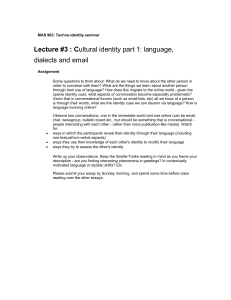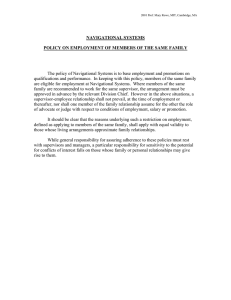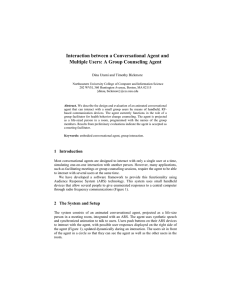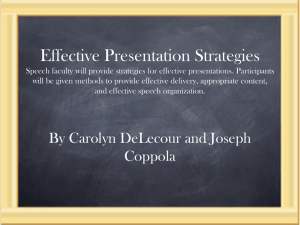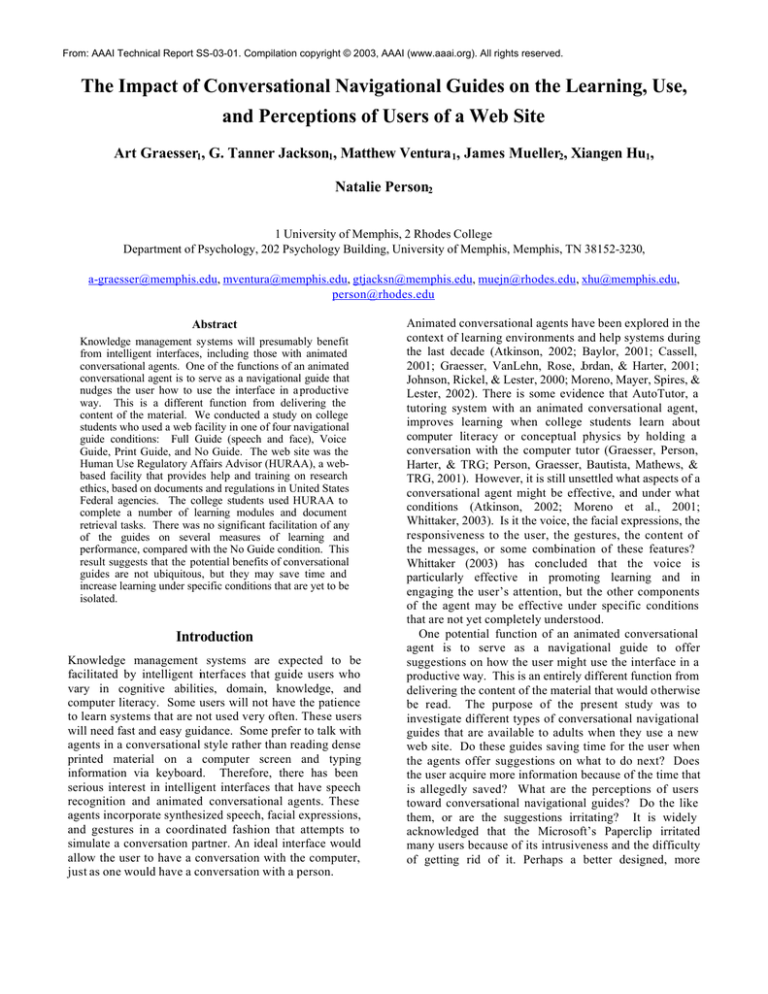
From: AAAI Technical Report SS-03-01. Compilation copyright © 2003, AAAI (www.aaai.org). All rights reserved.
The Impact of Conversational Navigational Guides on the Learning, Use,
and Perceptions of Users of a Web Site
Art Graesser1, G. Tanner Jackson1, Matthew Ventura 1, James Mueller2, Xiangen Hu1,
Natalie Person2
1 University of Memphis, 2 Rhodes College
Department of Psychology, 202 Psychology Building, University of Memphis, Memphis, TN 38152-3230,
a-graesser@memphis.edu, mventura@memphis.edu, gtjacksn@memphis.edu, muejn@rhodes.edu, xhu@memphis.edu,
person@rhodes.edu
Abstract
Knowledge management systems will presumably benefit
from intelligent interfaces, including those with animated
conversational agents. One of the functions of an animated
conversational agent is to serve as a navigational guide that
nudges the user how to use the interface in a productive
way. This is a different function from delivering the
content of the material. We conducted a study on college
students who used a web facility in one of four navigational
guide conditions: Full Guide (speech and face), Voice
Guide, Print Guide, and No Guide. The web site was the
Human Use Regulatory Affairs Advisor (HURAA), a webbased facility that provides help and training on research
ethics, based on documents and regulations in United States
Federal agencies. The college students used HURAA to
complete a number of learning modules and document
retrieval tasks. There was no significant facilitation of any
of the guides on several measures of learning and
performance, compared with the No Guide condition. This
result suggests that the potential benefits of conversational
guides are not ubiquitous, but they may save time and
increase learning under specific conditions that are yet to be
isolated.
Introduction
Knowledge management systems are expected to be
facilitated by intelligent interfaces that guide users who
vary in cognitive abilities, domain, knowledge, and
computer literacy. Some users will not have the patience
to learn systems that are not used very often. These users
will need fast and easy guidance. Some prefer to talk with
agents in a conversational style rather than reading dense
printed material on a computer screen and typing
information via keyboard. Therefore, there has been
serious interest in intelligent interfaces that have speech
recognition and animated conversational agents. These
agents incorporate synthesized speech, facial expressions,
and gestures in a coordinated fashion that attempts to
simulate a conversation partner. An ideal interface would
allow the user to have a conversation with the computer,
just as one would have a conversation with a person.
Animated conversational agents have been explored in the
context of learning environments and help systems during
the last decade (Atkinson, 2002; Baylor, 2001; Cassell,
2001; Graesser, VanLehn, Rose, Jordan, & Harter, 2001;
Johnson, Rickel, & Lester, 2000; Moreno, Mayer, Spires, &
Lester, 2002). There is some evidence that AutoTutor, a
tutoring system with an animated conversational agent,
improves learning when college students learn about
computer literacy or conceptual physics by holding a
conversation with the computer tutor (Graesser, Person,
Harter, & TRG; Person, Graesser, Bautista, Mathews, &
TRG, 2001). However, it is still unsettled what aspects of a
conversational agent might be effective, and under what
conditions (Atkinson, 2002; Moreno et al., 2001;
Whittaker, 2003). Is it the voice, the facial expressions, the
responsiveness to the user, the gestures, the content of
the messages, or some combination of these features?
Whittaker (2003) has concluded that the voice is
particularly effective in promoting learning and in
engaging the user’s attention, but the other components
of the agent may be effective under specific conditions
that are not yet completely understood.
One potential function of an animated conversational
agent is to serve as a navigational guide to offer
suggestions on how the user might use the interface in a
productive way. This is an entirely different function from
delivering the content of the material that would otherwise
be read. The purpose of the present study was to
investigate different types of conversational navigational
guides that are available to adults when they use a new
web site. Do these guides saving time for the user when
the agents offer suggestions on what to do next? Does
the user acquire more information because of the time that
is allegedly saved? What are the perceptions of users
toward conversational navigational guides? Do the like
them, or are the suggestions irritating? It is widely
acknowledged that the Microsoft’s Paperclip irritated
many users because of its intrusiveness and the difficulty
of getting rid of it. Perhaps a better designed, more
conversationally appropriate, agent would be more
appreciated by the user.
We conducted a study on 155 college students who used
a web facility in one of four navigational guide conditions:
Full Guide (speech and face), Voice Guide, Print Guide, and
No Guide. The web site was the Human Use Regulatory
Affairs Advisor (HURAA), a web-based facility that
provides help and training on the ethical use of human
subjects in research, based on documents and regulations
in United States Federal agencies (Graesser, Hu, Person,
Stewart, Toth, Jackson, Susarla, & Ventura, 2002). The
college students used HURAA to complete a number of
training modules and document retrieval tasks.
Different Types of Navigational Guides
The Full Guide was a talking head with synthesized
speech, facial expressions, and pointing gestures. The
Agent told the user what to do next when the user first
encountered a web page. For example, when the user
entered the “Explore Issues” module, the Agent said,
“Select the issue that you would like to explore.” The
talking head also moved to direct the user’s attention to
some point on the display. For example, the talking head
looked down when he said “You may select one of the
options below me.” The talking head told the user what
each primary and secondary module was supposed to do,
after the user rested the mouse pointer over a module link
for more than 2 seconds. The Agent was designed to
project an authoritative persona and to help the user
navigate through the interface more quickly. Many novice
users are lost and don’t know what to do next when they
encounter a page. The Agent was designed to reduce this
wasted time.
In order to directly test the influence of the Agent as a
navigational guide, participants were randomly assigned
to one of the following four conditions:
(a) Full Guide. There is the full talking head.
(b) Voice Guide. There is a voice that speaks, but no
head.
(c) Print Guide. The guidance messages are printed at
the location where the talking head normally is.
(d) No Guide. There are no messages of navigational
guidance, either spoken or in print.
If a navigational guide is important, then the completion
of the various tasks should be poorer in the No Guide
condition than the other three conditions: d < min{a, b, c}.
When considering the three conditions with the guidance,
there is a question of what medium is effective. If speech
reigns supreme, then c < min{a,b}. This would be
predicted by available research that has compared the
impact of spoken versus printed text on comprehension
and memory (Atkinson, 2002; Moreno et al., 2001;
Whittaker, 2003). If print is superior, then the prediction
would be that c > max{a,b}. If the presence of the face
provides a persona effect that improves interactivity
(Johnson et AL., 2000), then the prediction is a > b.
However, if the face is a distraction from the material in the
main display, then the prediction is a < b.
Human Use Regulatory Affairs Advisor
(HURAA)
HURAA is a web-based facility that provides help,
training, and information retrieval on the ethical use of
human subjects in research. The content of HURAA is
derived from Federal agency documents and regulations,
particularly the National Institutes of Health (NIH, 45 CFR
46), the Department of Defense (32 CFR 219; DoD
Directive 3216.2), and particular branches of the US
military.
The targeted users of HURAA focus on
fundamental ethical issues, but not the detailed
procedures and paper work associated with gaining
approval from Institutional Review Boards.
The design of HURAA was guided by a number of
broader objectives. The layout and design of the web
facility incorporate available guidelines in human factors,
human-computer interaction, and cognitive science. The
architecture of the HURAA components needed to be
conformant with the ADL standards for reusable
instructional objects, as specified in the Sharable Content
Objects Reference Model (SCORM, 2001). The primary
objective of having these standards is to allow course
content to be shared among different lesson planners,
computer platforms, and institutions. HURAA was
designed to optimize both learning and information
transmission. Adult users are likely to have very little
time, so it is important to optimize the speed and quality of
learning in web-based distance learning environments.
This requires careful consideration of the pacing of the
information delivery, the selection of content, and design
of the tasks to be performed. The web site was supposed
to be engaging to the user, so there was persuasive
multimedia intended to hook the user to continue on the
website. Finally, HURAA incorporated some of the
sophisticated pedagogical techniques that have been
implemented in advanced learning environments with
intelligent tutoring systems and animated conversational
agents.
HURAA has a number of standard features of
conventional web facilities and computer-based training,
such as hypertext, multimedia, help modules, glossaries,
archives, links to other sites, and page-turning didactic
instruction. HURAA also has more intelligent features
that allegedly promote deeper mastery of the material,
such as lessons with case-based and explanation-based
reasoning, document retrieval though natural language
queries, animated conversational agents, and context sensitive Frequently Asked Questions (called Point &
Query, Graesser, Langston, & Baggett, 1993). Additional
details about HURAA can be found in Graesser, Hu et al.,
2002). This paper directly focuses on some of the tasks
users would complete with HURAA and what impact the 4
different guides had on the completion of these tasks and
the users’ perceptions of the learning environment.
Materials and Procedure
The experiment included three benchmark tasks that
participants completed while interacting with HURAA.
This was followed by a series of tests and surveys that
were completed after they interacted with HURAA. We
refer to these two phases as the HURAA acquisition
phase and the post-HURAA test phase, respectively. The
next section describes the modules and HURAA facilities
that are directly relevant to the performance evaluation.
The participants were 155 undergraduate students at the
University of Memphis and Rhodes College who
participated for course credit or for money ($20).
HURAA Acquisition Phase
(1) Introduction. The Introduction Module is a multimedia
movie that plays immediately after a new user has logged
in. It is available for replay for users who want to see a
repeat. The Introduction is intended to impress the user
with the importance of protecting human subjects in
research. It introduces the user to the basic concepts of
the Common Rule (NIH, 45 CFR 46; 32 CFR 219), of the
Belmont Report’s coverage of beneficence, justice, and
respect for persons, and of the Seven Critical Issues that
must be scrutinized when evaluating any case (Emmanual
et al., 2000): Social and scientific value, accepted scientific
principles, fair subject selection, informed consent,
minimizing risks and maximizing benefits, independent
review, and respect for subjects. The Introduction was
prepared by an accomplished expert in radio and webbased entertainment industries, after rounds of feedback
from a panel of DoD personnel.
(2) Lessons. This module has four lessons that teach the
user about the Seven Critical Issues identified by
Emmanuel et al. (2000) and how to apply them to particular
cases that involve ethical abuses. This is a form of casebased reasoning (Ashley, 1990; Kolodner, 1984). The first
lesson presented the user with descriptions of the Seven
Critical Issues, a summary of the Tuskegee Syphilis Study,
and an explanation of how each of the Seven Critical
Issues was violated in the Tuskegee study. The second
lesson presented the user with a description of a study on
post traumatic stress disorders. The user was then
presented with the Seven Critical Issues and must decide,
on a six-point scale, the extent to which there potentially is
a problem with each issue in that case. The six point scale
is: 1 = Definitely not a problem, 2 = most likely not a
problem, 3 = undecided, guess it’s not a problem, 4 =
undecided, guess it’s a problem, 5 = most likely a problem,
and 6 = definitely a problem. The user then received
feedback comparing his/her responses with those of a
panel of experts from the DoD, along with a brief
explanation.
Discrepancies between the learner’s
decisions and the judgments of the experts were
highlighted. Lesson 3 followed the same procedure as
Lesson 2, except there was another case on a routine flight
test with an experimental helmet. Lesson 4 presented two
additional cases, following the same procedure. One was
on helmet-mounted devices and the other on
chemotherapy.
Signal detection analyses were performed on the
learner’s decisions as a measure of performance. There
are four categories of decisions when signal detection
analyses are applied.
- Hit (H). Both the learner and expert agree that an
issue is potentially problematic for the particular case.
- Correct rejection (CR). Both the learner and expert
are in agreement that an issue is not potentially
problematic for a case.
- Miss (M). The expert believes there is a potential
problem, but the learner does not.
- False alarm (FA). The learner believes there is a
problem, but the expert believes there is no problem.
The experts were 7 experts on research ethics in the
military. A d’ score was also computed that assesses how
well the learner can discriminate whether a case does
versus do not have a problem with respect to an issue. A
d’ score of 0 means the learner is not at all discriminating
whereas the score increases to the extent that the user is
progressively more discriminating (with an upper bound of
about 4.0).
(3) Query Documents. This module allows the user to ask
a natural language question (or description) and then
generates an answer by retrieving high matching excerpts
from various documents in the HURAA web site. For
each document that the user selects, the highest matching
paragraph from the document space is selected by the
computational linguistics software and is displayed in a
window. Beneath this window, the headings for the next
four results appear. If the top choice is not the one that
the user needs, s/he can click on the headings to read
those excerpts. The search engine that was available to
identify the optimal matches was latent semantic analysis
(Landauer et al., 1998; Graesser, P. Wiemer-Hastings, K.
Wiemer-Hastings, Person, & Harter, 2000).
In the search task, the participants were instructed to
search the document space in order to find answers to 4
test questions. The participants recorded the answers in
a test booklet. If the answer to a question was lengthy,
they were instructed to write down the fetched document
and section number where the answer was found.
Performance was measured by retrieval time and the
likelihood of retrieving the correct paragraph out of the
large document space. If the natural language query
facilities are useful, then there should be facilitation in the
speed and likelihood of accessing the correct documents.
Tests in the Test Phase
The test consisted of three parts: (1) Memory (a test on
the important ideas from the Introduction and Lessons),
(2) Issue comprehension (a test on the participant’s ability
to identify potentially problematic issues in cases), and (3)
Perception ratings (ratings on how the participants
viewed the learning experiences).
Memory for Important Ideas. This phase tests memory for
the central, core ideas from the Introduction and Lesson
material. These core concepts are those that all users
should take away from the learning experience. Memory
was assessed in three subtests: Free recall, cued recall,
and the cloze task. The free recall test presented a series
of concepts that the participants were asked to define or
describe off of the top of their head. After finishing the
free recall task, the cued recall test was administered on
the next page. The cued recall test had more retrieval cues
than the free recall test. The cloze procedure has the most
retrieval cues.
It took verbatim segments of the
introductory text and left out key words, which the
participant filled in. There were progressively more
retrieval cues for content to be retrieved as one goes from
free recall to the cloze task.
Issue Comprehension.
This test assessed how
discriminating the participants were in identifying
potentially problematic issues on two cases. The cases
were selected systematically so that 6 of the issues were
problematic in one and only one of the two cases; one of
the issues was problematic in both cases so it was not
scored. This test is functionally a transfer test from the
case-based, explanation-based reasoning task in the
HURAA acquisition phase. The participants simply read
each case and rated the seven issues on the 6-point scale
(as to whether issue I was problematic for case C.
Perception Ratings. The participants gave ratings on
their perceptions of the learning environments. The four
rating scales that were included in all three experiments are
presented below. The values on each rating scale were: 1
= disagree, 2 = somewhat disagree, 3 = slightly disagree, 4
= slightly agree, 5 = somewhat agree, and 6 = agree.
Examples are as follows: You learned a lot about human
subjects protections.” and “It was easy to use and learn
from these instructional materials.”
Results and Discussion
Table 1, on the last page, presents means and standard
deviations of the dependent measures in the four
experimental conditions. The most striking finding from
the experiment is the lack of significant differences among
conditions. In fact, there were no significant differences
among the conditions for any of the 13 dependent
measures in Table 1. This null result is incompatible with
all of the above predictions. It should be emphasized that
the sample size was quite large so the likelihood of a type
II error was not high.
The practical implication of the result is that the
animated conversational agent did not facilitate learning,
usage, and perceptions of the interface. In essence, the
agent and the conversational guidance had no bang for
the buck. Perhaps the web facility was designed extremely
well, so well that a navigational guide was superfluous.
The navigational agent might prove to be more effect
when the information on the screen is more complex,
congested, and potentially confusing.
Knowledge
management systems often have complex information
displays so the value of these agents may increase as a
function of the complexity, ambiguity, and perplexity of
the system. Perhaps there are special conditions when a
navigational guide of some form will be helpful, whether it
be print, voice, or a talking head. However, these precise
conditions have yet to be discovered and precisely
specified in the literature.
It is appropriate to acknowledge that the results of the
present study on agents as navigational guides does not
generalize to other learning environments. Animated
conversational agents have proven to be effective when
they deliver information and learning material in
monologues and tutorial dialogues (Atkinson, 2002;
Moreno et al., 2001; Person et al., 2001), particularly when
the test taps deep levels of comprehension. However,
only a handful of empirical studies has systematically
investigated the impact of these conversational agents on
learning, so more research is definitely needed. One
intriguing finding is that the amount of information that a
person learns and remembers from a learning system is not
significantly correlated with how much the learner likes the
system (Moreno, Klettke, Nibbaragandla, Graesser, &
TRG, 2002). Simply put, learning is unrelated to liking. It
this result is accurate, then it is not sufficient to simply ask
users and individuals in focus groups what they like or do
not like about agents and navigational guides. There also
needs to be a serious, deep, research arm that goes
beyond intuitions of users, designers, and managers.
Acknowledgements
This research was directly supported by contracts from
the Office of Naval Research (N61339-01-C1006) and the
Institute for Defense Analyses (AK-2-1801), and was
partially supported from grants by the National Science
Foundation (REC 0106965) and the DoD Multidisciplinary
University Research Initiative (MURI) administered by
ONR under grant N00014-00-1-0600. Any opinions,
findings, and conclusions or recommendations expressed
in this material are those of the authors and do not
necessarily reflect the views of ONR, IDA or NSF.
References
Ashley, K.D. (1990). Modeling legal argument: Reasoning
with cases and hypotheticals. Cambridge, MA: MIT
Press.
Atkinson, R.K. (2002). Optimizing learning from examples
using animated pedagogical agents.
Journal of
Educational Psychology, 94, 416-427.
Baylor, A.L. (2001). Investigating multiple pedagogical
perspectives through MIMIC (Multiple Intelligent
Mentors Instructing Collaboratively). Workshop on
agents at the AI-ED International Conference. San
Antonio, TX.
Cassell, J. (2001). Embodied conversational agents:
Representation and intelligence in user interfaces. AI
Magazine, 22, 67-83.
Collins, A., Neville, P., & Bielaczyc, K. (2000). The role of
different media in designing learning environments.
International Journal of Artificial Intelligence in
Education, 11, 144-162.
32 CFR 219 (1991). Protection of Human Subjects,
Department of Defense.
DoD Directive 3216.2 (1993). Protection of Human
Subjects in DoD supported research, Department of
Defense.
Emmanuel, E. J., Wendler, D., & Grady, C. (2000). What
makes clinical research ethical? Journal of the American
Medical Association, 283, 2701-2711.
Graesser, A.C., Hu, X., Person, N.K., Stewart, C., Toth, J.,
Jackson, G.T., Susarla, S., Ventura, M. (2002). Learning
about the ethical treatment of human subjects in
experiments on a web facility with a conversational
agent and ITS components. In S. A. Cerri (Ed.),
Proceedings of Intelligent Tutoring Systems 2002 (pp.
xx-xx). Berlin, Germany: Springer.
Graesser, A. C., Langston, M. C., & Baggett, W. B. (1993).
Exploring information about concepts by asking
questions. In G. V. Nakamura, R. M. Taraban, & D.
Medin (Eds.), The psychology of learning and
motivation: Vol. 29. Categorization by humans and
machines (pp. 411-436). Orlando, FL: Academic Press.
Graesser, A.C., Person, N., Harter, D., & TRG (2001).
Teaching tactics and dialog in AutoTutor. International
Journal of Artificial Intelligence in Education, 12, 257279.
Graesser, A.C., VanLehn, K., Rose, C., Jordan, P., & Harter,
D. (2001).
Intelligent tutoring systems with
conversational dialogue. AI Magazine, 22, 39-51.
Graesser, A.C., Wiemer-Hastings, P., Wiemer-Hastings, K.,
Harter, D., Person, N., & TRG (2000). Using latent
semantic analysis to evaluate the contributions of
students in AutoTutor.
Interactive Learning
Environments, 8, 129-148.
Johnson, W. L., & Rickel, J. W., & Lester, J.C. (2000).
Animated pedagogical agents: Face-to-face interaction
in interactive learning environments. International
Journal of Artificial Intelligence in Education, 11, 47-78.
Kolodner, J. (1984). Retrieval and organizational strategies
in conceptual memory: A computer model. Hillsdale, NJ:
Erlbaum..
Landauer, T.K., Foltz, P.W., Laham, D. (1998). An
introduction to latent semantic analysis. Discourse
Processes, 25, 259-284.
Mayer, R.E. (1997). Multimedia learning: Are we asking
the right questions? Educational Psychologist, 32, 1-19.
Moreno, K.N., Klettke, B., Nibbaragandla, K., Graesser,
A.C., & the Tutoring Research Group (2002). Perceived
characteristics and pedagogical efficacy of animated
conversational agents. In S. A. Cerri, G. Gouarderes, &
F. Paraguacu (Eds.), Intelligent Tutoring Systems 2002
(pp. 963-971). Berlin, Germany: Springer.
Moreno, R., Mayer, R.E., Spires, H.A., & Lester, J.C.
(2002). The case for social agency in computer-based
teaching: Do students learn more deeply when the
interact with animated pedagogical agents? Cognition
& Instruction, 19, 177-213.
NIH 45 CFR 46 (1991). National Institutes of Health Code
of Federal Regulations, Protection of Human Subjects.
Person, N.K., Graesser, A.C., Bautista, L., Mathews, E., &
TRG (2001). Evaluating student learning gains in two
versions of AutoTutor. In J.D. Moore, C.L. Redfield,
and W.L. Johnson (Eds.) Artificial Intelligence in
Education: AI-ED in the Wired and Wireless Future (pp.
286-293). Amsterdam: OIS Press.
Sharable Content Object Reference Model (SCORM),
Versions 1.1 and 1.2. www.adlnet.org.
Whittaker, S. (2003). Theories and methods in mediated
communication. In A.C. Graesser, M.A. Gernsbacher,
and S.R. Goldman (Eds.). Handbook of discourse
processes. Mahwah, NJ: Erlbaum.
Table 1. Means (and Standard Deviations) for Dependent Measures.
--------------------------------------------------------------------------------------------------DEPENDENT
Full
Voice
Print
No
MEASURES
Guide
Guide
Guide
Guide
------------------------------------------------------------------------------------------------Number of participants
40
39
38
38
Memory for Core Concepts
Free recall proportion
.45 (.21)
Cued Recall proportion
.51 (.24)
Cloze recall proportion
.44 (.15)
Introduction study time (minutes) 6.6 (3.3)
Problematic Issue Identification
Hit proportion
False alarm proportion
d’ score (discrimination)
Task completion time (minutes)
.43 (.20)
.50 (.23)
.42 (.18)
9.3 (19.0)
.42 (.21)
.45 (.26)
.39 (.17)
7.4 (4.7)
.44 (.20)
.53 (.23)
.47 (.19)
10.7 (19.8)
.58 (.10)
.58 (.10)
.56 (.12)
.60 (.13)
.40 (.32)
.39 (.30)
.38 (.34)
.38 (.31)
.30 (.46)
.31 (.36)
.14 (.75)
.27 (.74)
23.7 (6.2) 23.7 (8.1) 20.8 (5.2) 22.9 (4.1)
Search for Information
Correct document retrieval prop. .55 (.25)
.50 (.49)
Search time (minutes)
27.1 (11.4) 24.4 (9.6)
.47 (.23)
23.5 (9.2)
.52 (.25)
24.8 (7.9)
Perception ratings
Amount learned
4.75 (1.06) 4.62 (1.16) 4.61 (1.08) 4.53 (1.48)
Interest
3.85 (1.63) 4.08 (1.46) 4.11 (1.41) 3.79 (1.82)
Enjoyment
3.50 (1.47) 3.46 (1.48) 3.58 (1.41) 2.89 (1.47)
Ease of learning
4.13 (1.40) 3.95 (1.45) 3.71 (1.71) 3.61 (1.57)
-------------------------------------------------------------------------------------------------------------

